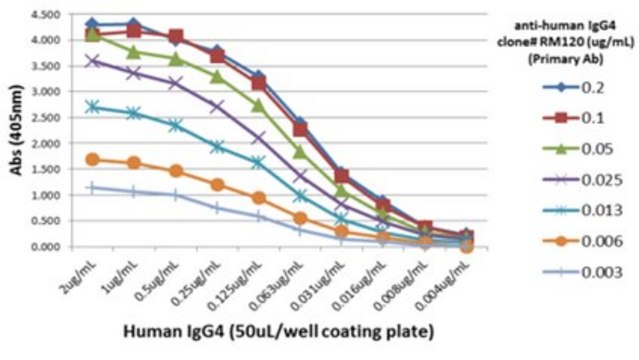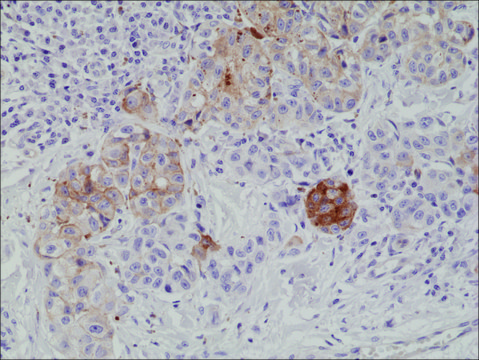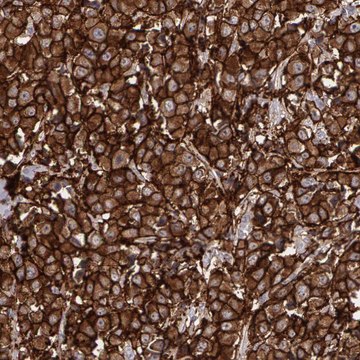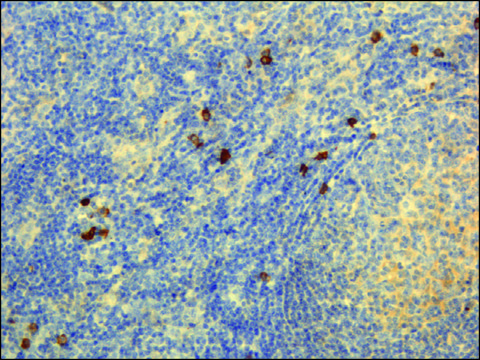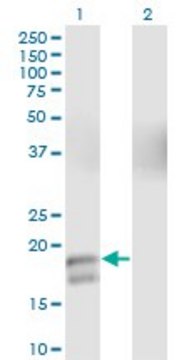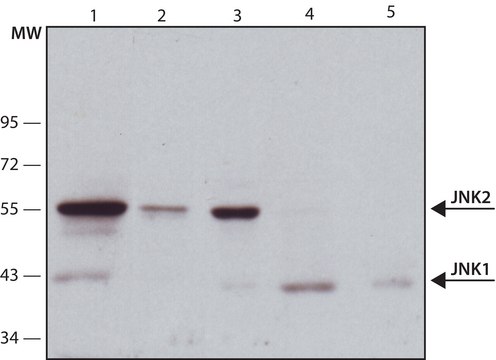05-1076
Anti-c-Jun Antibody, clone 6E4.4
clone 6E4.4, from mouse
Sign Into View Organizational & Contract Pricing
All Photos(3)
Synonym(s):
JNK1 alpha protein kinase, JNK1 beta protein kinase, JUN N-terminal kinase, Stress-activated protein kinase JNK1, c-Jun N-terminal kinase 1, mitogen-activated protein kinase 8, mitogen-activated protein kinase 8 isoform JNK1 alpha1, mitogen-activated pro
UNSPSC Code:
12352203
eCl@ss:
32160702
NACRES:
NA.41
Recommended Products
biological source
mouse
Quality Level
antibody form
purified immunoglobulin
antibody product type
primary antibodies
clone
6E4.4, monoclonal
species reactivity
mouse, human, rat
packaging
antibody small pack of 25 μg
technique(s)
immunocytochemistry: suitable
western blot: suitable
isotype
IgG1κ
NCBI accession no.
UniProt accession no.
shipped in
ambient
target post-translational modification
unmodified
Gene Information
human ... JUN(3725)
mouse ... Jun(16476)
rat ... Jun(24516)
Related Categories
General description
c-Jun is a component of the transcription factor AP-1 that binds and activates transcription at TRE/AP-1 elements and appears to be a major downstream target of the SAPK/JNK signaling pathway. The transcriptional activity of c-Jun is regulated by phosphorylation at Ser63 and Ser73. Extracellular signals including growth factors, transforming oncoproteins and UV irradiation stimulate phosphorylation of c-Jun at Ser63/73 and activate c-Jun dependent transcription. Mutation of Ser63/73 renders c-Jun nonresponsive to mitogenic and stress induced signaling pathways. The MAP kinase homologue, SAPK/JNK, binds to the N-terminal region of c-Jun and phosphorylates c-Jun at Ser63/73. In addition, the activity of SAPK/JNK is stimulated by the same signals that activate c-Jun.
Specificity
This antibody detects c-Jun, regardless of phosphorylation state.
Immunogen
GST-tagged recombinant protein corresponding to c-Jun.
Application
Anti-c-Jun Antibody, clone 6E4.4 is a Mouse Monoclonal Antibody for detection of c-Jun also known as JNK1 alpha protein kinase, JNK1 beta protein kinase & has been validated in WB, ICC.
Research Category
Epigenetics & Nuclear Function
Epigenetics & Nuclear Function
Research Sub Category
Transcription Factors
Transcription Factors
Western Blot Analysis (SNAP ID Technique): 5 µg/mL of this antibody detected c-Jun on 15 µg of NIH/3T3 cell lysate using the SNAP ID Tecnique).
Immunocytochemistry Analysis: Confocal fluorescent analysis of HeLa, C2C12, and A431 cells using anti-c-Jun, clone 6E4.4 mouse monoclonal antibody (see page 2).
Immunocytochemistry Analysis: Confocal fluorescent analysis of HeLa, C2C12, and A431 cells using anti-c-Jun, clone 6E4.4 mouse monoclonal antibody (see page 2).
Quality
Evaluated by Western Blot in NIH/3T3 cell lysate.
Western Blot Analysis: 0.5-2 µg/mL of this antibody detected c-Jun on 15 µg of NIH/3T3 cell lysate.
Western Blot Analysis: 0.5-2 µg/mL of this antibody detected c-Jun on 15 µg of NIH/3T3 cell lysate.
Target description
~36-43 kDa
Multiple bands may be visible, indicating various phosphorylation states.
Multiple bands may be visible, indicating various phosphorylation states.
Linkage
Replaces: 04-210
Physical form
Format: Purified
Protein G Purified
Purified mouse monoclonal IgG1κ in buffer containing 0.1 M Tris-Glycine (pH7.4), 150 mM NaCl with 0.05% sodium azide.
Storage and Stability
Stable at 2-8°C for 1 year from date of receipt.
Analysis Note
Control
NIH/3T3 cell lysate
NIH/3T3 cell lysate
Other Notes
Concentration: Please refer to the Certificate of Analysis for the lot-specific concentration.
Disclaimer
Unless otherwise stated in our catalog or other company documentation accompanying the product(s), our products are intended for research use only and are not to be used for any other purpose, which includes but is not limited to, unauthorized commercial uses, in vitro diagnostic uses, ex vivo or in vivo therapeutic uses or any type of consumption or application to humans or animals.
Regulatory Information
新产品
Certificates of Analysis (COA)
Search for Certificates of Analysis (COA) by entering the products Lot/Batch Number. Lot and Batch Numbers can be found on a product’s label following the words ‘Lot’ or ‘Batch’.
Already Own This Product?
Find documentation for the products that you have recently purchased in the Document Library.
Subhadeep Chakrabarti et al.
Journal of vascular research, 50(1), 21-34 (2012-10-26)
The sex hormone estradiol (E(2)) appears to mediate both anti-atherogenic and pro-inflammatory effects in premenopausal women, suggesting a complex immunomodulatory role. Tumor necrosis factor (TNF) is a key pro-inflammatory cytokine involved in the pathogenesis of atherosclerosis and other inflammatory diseases.
Subhadeep Chakrabarti et al.
PloS one, 7(12), e52357-e52357 (2013-01-04)
Estrogen, the female sex hormone, is known to exert anti-inflammatory and anti-atherogenic effects. Traditionally, estrogen effects were believed to be largely mediated through the classical estrogen receptors (ERs). However, there is increasing evidence that G-protein coupled receptor 30 (GPR30), a
Subhadeep Chakrabarti et al.
PloS one, 10(2), e0117492-e0117492 (2015-02-26)
Milk derived tripeptides IPP (Ile-Pro-Pro) and VPP (Val-Pro-Pro) have shown promise as anti-hypertensive agents due to their inhibitory effects on angiotensin converting enzyme (ACE). Due to the key inter-related roles of hypertension, chronic inflammation and insulin resistance in the pathogenesis
Sukrit Promtang et al.
IBRO neuroscience reports, 14, 38-49 (2023-01-03)
The anti-apoptosis effect of germinated brown rice (GBR) focusing on differentiated HT22 cells results in improved nutritional values after the germination process of GBR which contains total phenolic compounds and γ-aminobutyric acid (GABA). Cell death induced by 5 mM glutamate was
Our team of scientists has experience in all areas of research including Life Science, Material Science, Chemical Synthesis, Chromatography, Analytical and many others.
Contact Technical Service